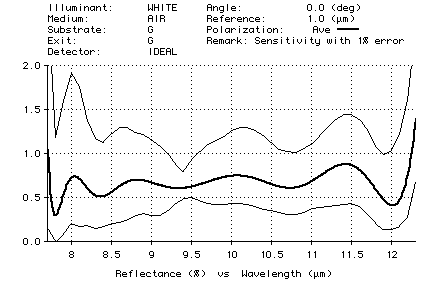Focus on: Sensitivity

In version 3.3, extensive changes were made to the sensitivity analysis:
- Worst-possible sensitivity analysis. On occasion, the designer may want to
know what the worst possible performance is for a given manufacturing error. In
the "Set Sensitivity Parameters" dialog, there is a new analysis type: Worst-possible.
When this option is selected, then subsequent use
of the Run menu's "Compute Sensitivity" command will compute the upper and lower
bounds of the design's performance. Unlike the other two analysis types, which
use random numbers to simulate manufacturing errors, the "worst-possible" calculation
is deterministic; at each wavelength, optimization is employed to find the two designs (with thicknesses
within the manufacturing tolerance) having the highest and lowest performance.
- Sensitivity analysis: vary QWOT. The designer may
choose to vary the quarter-wave optical thickness of layers. This type of analysis,
which can be used only on dielectric (k < 0.01) layers, is important for studying the
effects of thickness errors when coatings are optically monitored during their production.
- Index variation in sensitivity analysis. In the past, sensitivity analysis
varied only the physical thickness of the layers. Now the refractive index can
also be varied. When index is varied, the layers' optical thickness remains unchanged.
It is possible to vary thickness and index simultaneously.
- Increased the number of trials allowed in the sensitivity computation. The maximum number of trials was 32,767. It has been increased to 2,147,483,647.